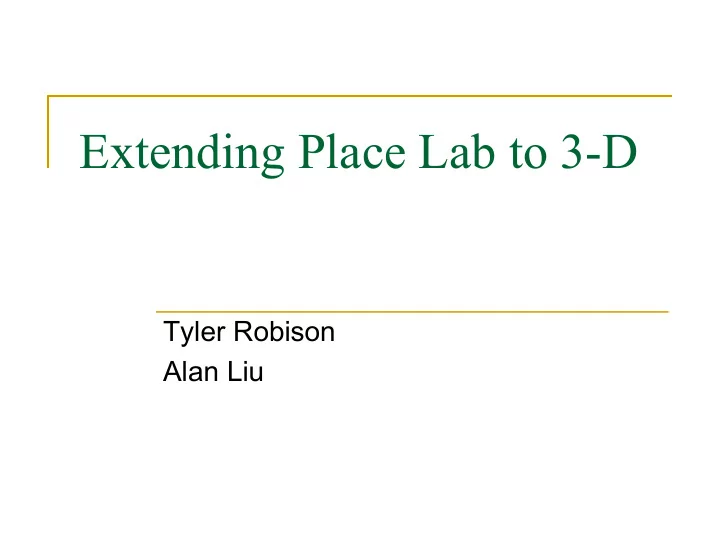

Extending Place Lab to 3-D Tyler Robison Alan Liu
Basic concept Want to determine location inside a building Sample applications: Position-aware reminders Location-aware buddy list Guidance for the cognitively impaired Smart conference rooms
Idea
Collecting data •Beacon readings and ground truth were collected using a GUI showing map of each floor
Intel's Place Lab Java codebase Provides basic localization functionality Reading signals WiFi GPS Particle filters GUI classes Designed to be extended
Research issues How to interpret beacon readings Compute centroid of APs heard Use particle filter Place Lab extensions: Beacon database includes extra information (e.g., floor) Sensor model updated to include signal attenuation due to floors Motion model updated to change floor variable
Evaluation– floor estimation
Evaluation – location estimation Mean 2d error Median 2d error Std. dev. Particle filter 31.4m 32.3 11.9 Centroid of 12.6 11.2 9.0 APs on floor •Particle filter uses original sensor model (based on signal strength ), with a floor attenuation factor of 0.8 •Centroid first computes the mode of the stronger half of APs heard to determine floor, then takes the centroid of those APs •Note: highly calibrated fingerprinting systems can get 5-10m accuracy
Improving accuracy Sensor model Classify APs based on their physical properties (model-based) Empirically learn AP properties (histogram- or fingerprint-based) Binning based on response rate at different distances from APs Bin size of 10m produces mean 2d error of 17.2m, median error of 14.5m Doesn't take into account effects across different floors: only gets right floor 15% of the time, within 1 floor 87% of the time Binning based on distance and floor Bin size of 10m produces mean 2d error of 16.4m, median error of 16.0m Gets right floor 56% of the time, within 1 floor 99% of the time
Map Based Particle Filter Take into account knowledge of environment Walls Open spaces Stairwells/elevators Intuitively, a signal passing through several walls should be weaker Mobile computers shouldn't change floors unless in an elevator or stairwell For each particle in particle filter, use this information to decide what its likelihood is
Barometric pressure
Tradeoffs Can get better accuracy with More extensive fingerprinting Additional sensors (accel, barometric, ultrasound) But this comes at a price (time and money) Data collection and management Equipment calibration This limits scalability
Thanks! Questions?
Recommend
More recommend